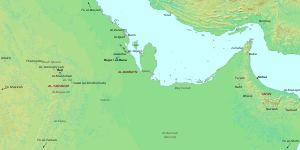Abu Sa'id al-Jannabi
| Abu Sa'id Hasan ibn Bahram al-Jannabi | |
|---|---|
| Ruler of the Qarmatian Isma'ilism |
Abu Sa'id Hasan ibn Bahram al-Jannabi (
His religious teachings and political activities are somewhat unclear, as they are reported by later and usually hostile sources, but he seems to have shared the
Early life
Abu Sa'id was of
There he married into the Banu'l-Qassar family, who were prominent members of the
Conquest of Bahrayn

According to the report of
According to the 10th-century historian
The
With the backing of a strong Bedouin army, Abu Sa'id began attacking towns in the area: Qatif,
In 899, a major rift occurred in the Isma'ili movement, when Hamdan Qarmat and Abu Muhammad Abdan denounced the movement's secret leadership at
By 899, Abu Sa'id's followers controlled most of Bahrayn, except for the regional capital
Despite the destruction visited upon it, Hajar remained the chief city and capital of Bahrayn. Abu Sa'id, however, established his own palatial residence at al-Ahsa oasis,[2] where he ruled in the traditional manner of an Arab prince.[16] From Bahrayn, the Qarmatians launched a series of raids against the vicinities of Basra, both to capture slaves and in retaliation for the participation of the local Zabba tribe in the 900 campaign against them.[2] The most notable of these raids occurred in July/August 912, but although the local Abbasid governor was reportedly unable to confront it, the sources report that the force involved was very small, barely 30 men.[2][18]
Governance and doctrine
| Part of a series on Islam Isma'ilism |
|---|
 |
|
|
As the founder of the Qarmatian "
His religious teachings are less clear, as the Qarmatians of Bahrayn left no testimonies of their own; what is known about them is reported by few, foreign, and usually heavily hostile sources.
Following Isma'ili expectations that the mahdī would reveal the "hidden" or "inner" (bāṭin) truths of the religion to his followers, thus ushering an "age of pure spiritual knowledge" and making religious laws and customs obsolete,[25] Abu Sa'id abolished numerous Islamic rites, such as prayer and fasting.[2]
Death and succession
Al-Mas'udi reports that Abu Sa'id was murdered in June/July 913 while taking his bath in his palace by two
He left seven[1] or six[24] sons, who due to their youth were at first under the tutelage of their uncle Hasan, the last of the three Banu Sanbar brothers.[24] Power was likely nominally invested among all of Abu Sa'id's sons,[26] as a response composed soon after Abu Sa'id's death to a letter from the Abbasid vizier was written on behalf of all sons.[24] Among his sons, the oldest, Abu'l-Qasim Sa'id al-Jannabi, was at first the pre-eminent, but his reign was brief; he was replaced by the youngest son, Abu Tahir al-Jannabi, at the latest by 923.[27][28] The reason and manner of the transition is unclear. Most Arabic sources agree that Abu Sa'id had appointed him as his heir, but that he was deposed in 923 by Abu Tahir. Another tradition, by the Kufan anti-Isma'ili polemicist Abu Abdallah Muhammad ibn Ali ibn Rizam al-Ta'i, reports that Abu Sa'id had always intended for Abu Tahir to succeed him, and had named Sa'id only as regent, and that Sa'id voluntarily relinquished power to his brother in 917/918.[27]
Following his death, Abu Sa'id became the object of veneration by his followers. It was believed that he would
References
- ^ a b c d e f g h i j Carra de Vaux & Hodgson 1965, p. 452.
- ^ a b c d e f g h i j k l m n o p q r s t u v w x y z aa ab Madelung 1983.
- ^ a b Halm 1991, p. 37.
- ^ a b Halm 1991, pp. 37–38.
- ^ a b Rentz & Mulligan 1960, p. 942.
- ^ a b Daftary 2007, p. 110.
- ^ a b Halm 1991, p. 58.
- ^ Daftary 2007, pp. 116–117.
- ^ Madelung 1996, p. 24.
- ^ Madelung 1978, p. 660.
- ^ Madelung 1996, pp. 25, 28.
- ^ a b Daftary 2007, p. 121.
- ^ Madelung 1996, p. 25.
- ^ Halm 1991, pp. 67, 176.
- ^ Halm 1991, p. 176.
- ^ a b c Halm 1991, p. 59.
- ^ Halm 1991, pp. 59–60.
- ^ Madelung 1996, pp. 29–30.
- ^ Hitti 2002, p. 445.
- ^ Daftary 2007, pp. 110–111.
- ^ Öz 1993, p. 371.
- ^ Hitti 2002, pp. 444–445.
- ^ Rexroth 1974, p. 160.
- ^ a b c d e f Halm 1991, p. 225.
- ^ Daftary 2007, p. 132.
- ^ Madelung 1996, p. 39.
- ^ a b Madelung 1996, p. 37.
- ^ Daftary 2007, pp. 121, 147–148.
- ^ Daftary 2007, p. 111.
Sources
- OCLC 495469475.
- ISBN 978-0-521-61636-2.
- ISBN 978-3-406-35497-7.
- ISBN 0-333-63141-2.
- OCLC 758278456.
- ISBN 978-0-71009-093-5.
- ISBN 978-0-521-00310-0.
- Öz, Mustafa (1993). "Cennâbî, Ebû Saîd". TDV Encyclopedia of Islam, Vol. 7 (Ca'fer es-Sâdik – Ci̇ltçi̇li̇k) (in Turkish). Istanbul: ISBN 978-975-389-434-0.
- Rentz, G. & Mulligan, W. E. (1960). "al-Baḥrayn". In OCLC 495469456.
- ISBN 0-81649204-2.
Further reading
- Langaroodi, Reza Rezazadeh; Negahban, Farzin (2015). "Abū Saʿīd al-Jannābī". In ISSN 1875-9831.
